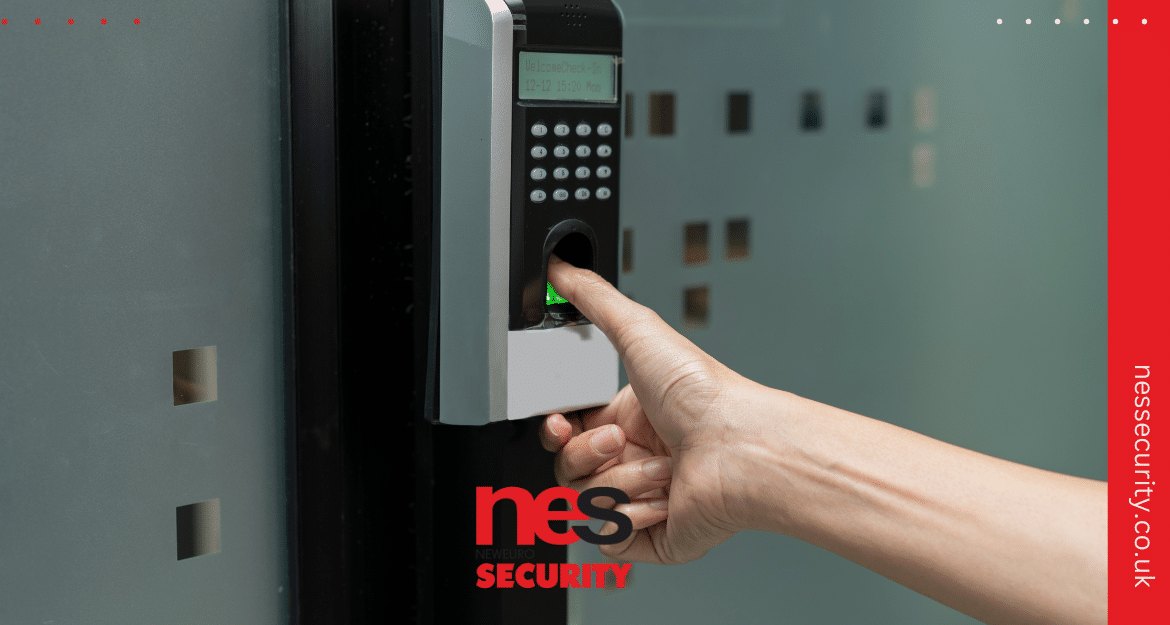In today’s rapidly evolving world, security remains a top priority for individuals and businesses alike. Traditional access control methods, such as keys or swipe cards, are gradually being replaced by more sophisticated and reliable solutions. One such cutting-edge technology gaining traction in the UK is fingerprint access control.
Leveraging the unique biometric characteristics of fingerprints, this system offers enhanced security and convenience. In this article, we delve into the world of fingerprint access control, exploring its technology, advantages, applications, and future trends, and how Nes Security can provide expert solutions tailored to your needs.
Understanding Fingerprint Access Control Technology
Fingerprint access control is a biometric security system that utilizes the unique patterns on an individual’s fingertips to grant or deny access. Each fingerprint has distinct ridge patterns, which are minutely analysed and encoded into digital templates within the access control system. When a user attempts to gain entry, the system captures their fingerprint and compares it to the stored templates to determine if access should be granted.
Advantages of Fingerprint Access Control Systems
- Unmatched Security: Fingerprint access control offers an unparalleled level of security since fingerprints are highly unique and virtually impossible to replicate. This eliminates the risk of unauthorised access due to lost or stolen cards or keys.
- Convenience and Speed: With fingerprint access control, users don’t need to carry keys or cards, eliminating the hassle of managing multiple access credentials. Additionally, the authentication process is quick, allowing for seamless and efficient access.
- Cost-Effective: Over time, traditional access control systems may incur costs for replacing lost cards or rekeying locks. Fingerprint access control reduces such expenses as it eliminates the need for physical credentials.
- Audit Trail and Accountability: The system maintains a detailed log of access events, providing a robust audit trail for monitoring and ensuring accountability.

Fingerprint Access Control for Enhanced Security
Fingerprint access control finds application in a wide range of settings, including commercial, residential, educational, healthcare, and government sectors. In commercial buildings, sensitive areas like server rooms, executive offices, and research laboratories can benefit from the heightened security offered by fingerprint access control. In residential properties, homeowners can protect their homes from intruders while enjoying the convenience of keyless entry. In educational institutions, fingerprint access control can safeguard restricted areas such as laboratories and administrative offices. In healthcare facilities, it helps control access to patient records and medical supplies, ensuring confidentiality and safety. Lastly, in government and public sectors, fingerprint access control is employed to secure classified information and control access to sensitive locations.
How Fingerprint Access Control Works
Fingerprint access control systems consist of several key components:
- Fingerprint Scanners: These capture an individual’s fingerprint and convert it into a digital template.
- Database: The system stores the digital templates of authorised users’ fingerprints for comparison during authentication.
- Controller: This acts as the brain of the system, managing user data, access rights, and the authentication process.
- Electric Locks: These are the physical mechanisms that grant or deny access based on the outcome of the authentication process.
The process of fingerprint authentication involves three main steps:
- Enrollment: During this initial setup phase, the system scans and records the fingerprints of authorised users, creating digital templates and linking them to the corresponding user profiles.
- Authentication: When a user seeks access, the fingerprint scanner captures their fingerprint, and the system compares it to the stored templates. If a match is found, access is granted; otherwise, it is denied.
- Granting Access: Upon successful authentication, the controller signals the electric lock to unlock the door, allowing the user to enter.
Key Components of Fingerprint Access Control Systems
- Biometric Scanners: The fingerprint scanner is a crucial component that captures the unique characteristics of a user’s fingerprint. Optical, capacitive, and ultrasonic scanners are some common types used in access control systems.
- Database and User Management: The database stores and manages the digital templates of authorised users, associating them with specific access rights and privileges.
- Control Panel: This acts as the central hub, coordinating communication between the components and overseeing the authentication process.
- Electric Locks: Electric strikes or magnetic locks are employed to control the opening and closing of doors physically.
Integrating Fingerprint Access Control with Existing Security Systems
One of the significant advantages of fingerprint access control is its compatibility with existing security systems. Fingerprint readers can be seamlessly integrated with other access control methods like swipe cards or key fobs, offering multi-factor authentication for added security. Moreover, many modern fingerprint access control systems support connectivity with building management systems and CCTV surveillance, creating a comprehensive security ecosystem.

Factors to Consider When Implementing Fingerprint Access Control
While fingerprint access control provides numerous benefits, certain factors should be considered before implementation:
- Accuracy and Reliability: The accuracy and reliability of the fingerprint scanner are critical to ensure smooth and secure access.
- Scalability: Choose a system that can accommodate future expansions and additions to the user base.
- User Enrollment and Management: User enrollment should be straightforward, and the system should allow efficient management of user profiles and access rights.
- Integration Capabilities: Ensure that the system can integrate with other security and building management systems.
Data Privacy and Compliance Considerations in Fingerprint Access Control
With biometric data being sensitive and personal, data privacy and compliance are paramount. Organisations using fingerprint access control must adhere to data protection regulations, ensuring the secure storage and handling of biometric data. Proper encryption and access controls should be in place to safeguard the data from unauthorised access.
Future Trends and Innovations in Fingerprint Access Control
As technology continues to advance, fingerprint access control is likely to witness ongoing innovations and improvements. Some future trends may include enhanced accuracy through artificial intelligence and machine learning algorithms, contactless fingerprint scanning, and increased integration with mobile devices.
Partnering with Nes Security for Expert Fingerprint Access Control Solutions in the UK
Nes Security is a leading provider of advanced security solutions, including fingerprint access control systems, in the UK. With our expertise and experience, we can tailor access control solutions to meet the unique needs of your residential or commercial property. Our team of professionals ensures seamless installation and integration, guaranteeing optimal performance and reliability.
Whether you need to secure a small office or a large-scale facility, Nes Security can provide cutting-edge fingerprint access control systems that elevate your security measures to new heights.
With Nes Security as your partner, you can rest assured that your access control needs will be met with the highest standards of quality and efficiency. Contact us today to explore how our fingerprint access control solutions can help enhance security and streamline access management on your premises.


